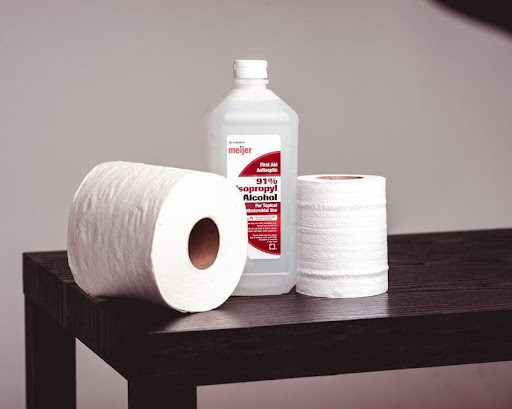As a kid, did you visit the nurse’s office after an elementary school playground wipeout? If so, you may remember the brown bottle, white cap, and cotton swab combo. You probably braced yourself in anticipation of “the stinging stuff”.
As an adult, you probably figured out the stinging stuff is rubbing alcohol. Maybe you’ve added a bottle of your own to a first aid kit at home. If you’ve been to the drug store to buy some, you may have noticed isopropyl alcohol nearby.
So what’s the difference? How do you know when to use isopropyl alcohol vs rubbing alcohol? Keep reading to find out.
Isopropyl Alcohol
Isopropyl alcohol is a chemical compound made from propane and water. It contains three carbon molecules, eight hydrogen molecules, and one oxygen. It’s commonly found in liquid form.
Isopropyl alcohol is completely colorless. It does, however, have a very distinctive odor. Scientists sometimes refer to isopropyl alcohol as IPA.
This is very different than an IPA you’d sample at your local bar. Beer IPAs are made with fermented ethyl alcohol, which is safe to drink.
Isopropyl alcohol IPA is not fermented and is very harmful or deadly if ingested. While isopropyl alcohol is natural, it is also a dangerous substance.
Common Uses
Why would people have an interest in such a harmful chemical? Here are several common purposes:
- Stripping paint
- As a household cleaner
- Lifting oils and stains
- Disinfecting surfaces
- Astringent
- To dilute other substances in lab work
It’s important to use isopropyl alcohol as directed in well-ventilated areas. Improper use can lead to serious harm or even death.
Rubbing Alcohol
Most rubbing alcohol has 68%-72% isopropyl alcohol content. The rest of most rubbing alcohol ingredients include perfume oils, water, added color, and denaturants. Some types of rubbing alcohol use ethyl alcohol instead of isopropyl alcohol but those are less common.
Why Is It Called Rubbing Alcohol?
The name rubbing alcohol was assigned to this substance in the 1920s. It wasn’t uncommon for rubbing alcohol to be used as a massage agent. Manufacturers would pair it with a nice-smelling perfume and masseurs would use it as a skin rub for clients during massage treatments.
You may recall the roaring twenties as the time of alcohol prohibition in the United States. By using the name rubbing alcohol, people were assured they were not breaking the law by buying this substance. The name also told individuals rubbing alcohol wasn’t for drinking.
Common Use
We may not use it as massage oil anymore, but rubbing alcohol is still commonly used in many US households. If you’ve ever used hand sanitizer, you’ve most likely used rubbing alcohol.
Many medical facilities use rubbing alcohol as a surface or skin disinfectant. If you’ve ever had a vaccine, the nurse likely used a swab of rubbing alcohol to clean the area before injecting. Most first aid kits have some form of rubbing alcohol because of their ability to instantly disinfect.
Isopropyl Alcohol Vs. Rubbing Alcohol
Why do the differences between isopropyl alcohol vs rubbing alcohol matter? Here’s a closer look at each substance.
Isopropyl Alcohol Guide
Isopropyl alcohol is less diluted than rubbing alcohol. Isopropyl alcohol is dangerous if ingested. Unless it’s specifically diluted in a hand sanitizer, isopropyl alcohol shouldn’t be used on the body.
It’s best to think of isopropyl alcohol as a substance to use on surfaces, not people or animals.
Rubbing Alcohol Guide
Rubbing alcohol, as stated earlier, can be used on skin surfaces. Since it contains isopropyl alcohol, you may be wondering, is rubbing alcohol flammable? The answer is, yes.
Since rubbing alcohol is usually diluted to 70% isopropyl alcohol and 30% water, it has a lower flashpoint than 99% isopropyl alcohol.
Important Safety Information
Isopropyl alcohol and rubbing alcohol should only be used as directed on each product’s packaging. Misuse or overuse can result in serious harm or even death. The CDC placed isopropyl alcohol in the IDLH category. This warns that a substance is “immediately dangerous to life and health”.
Ventilate
If you’re using isopropyl alcohol as a cleaner, paint thinner, or handling it in any way, the fumes could be very harmful. Always use isopropyl alcohol in a well-ventilated area. If you display any of these symptoms, seek immediate medical help:
- Eye irritation
- Nose irritation
- Cracking/dry skin
- Headache
- Throat irritation
- Feeling dizzy
- Feeling drowsy
Even when it’s diluted in rubbing alcohol, isopropyl alcohol exposure can cause animals to act intoxicated. If you suspect your pet has been overexposed to isopropyl alcohol, seek immediate veterinary attention.
Proper Storage
It’s very important to properly store isopropyl and rubbing alcohol. You can look up specific guidelines on OSHA’s website. Since it has such a low flashpoint (53 degrees Fahrenheit), improper storage could be literally playing with fire.
Isopropyl Alcohol and Rubbing Alcohol
When used according to safety guidelines, they help provide clean and safe medical, home, and work environments. Most rubbing alcohol contains isopropyl alcohol, which is why many people use the two terms interchangeably.
Rubbing alcohol is most often used to keep skin surfaces free from germs. Isopropyl alcohol (or IPA) is not used on humans or animals unless as an ingredient in rubbing alcohol. Isopropyl alcohol is commonly used to clean surfaces, strip paint, and remove oils from garages or shops.
Now you know the differences and similarities between isopropyl alcohol vs rubbing alcohol. Check out our blog to read more about pop culture, financial investing, lifestyle tips, and more.

